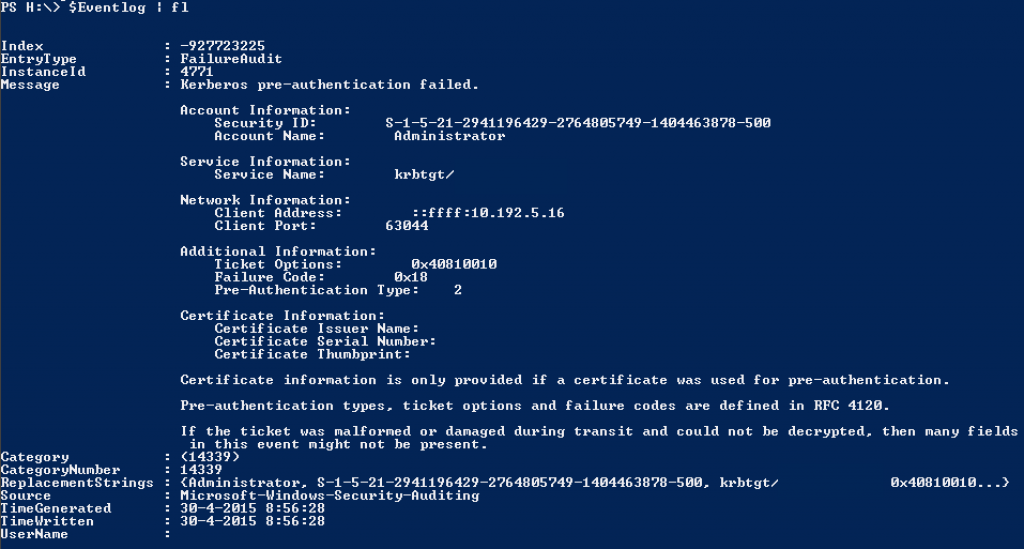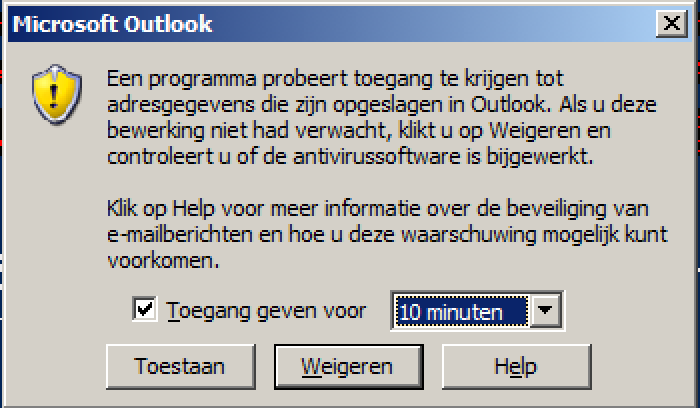The Administrator account is an account which you must monitor in a managed environment. You do not want this account to be exploited. For example I recently encountered an Administrator account which had a mailbox. To make matters worse the account had ActiveSync enabled. So if someone would authenticate with the Administrator account to Activesync it would become visible when you have the password right. A blackhat hacker could do a long term deployment in which he would try to authenticate multiple times per hour. He would be unnoticed in his attempts as long as he keeps the pace low. Imagine what a massive number of passwords you can try in two years time. If you have chosen a bad Administrator password you could end up being compromised. 105120 may seem like a low number but in reality many companies do not change this password frequently and if those companies started out with a weak password, the chance of being compromised is quite large.
What most companies also don’t do is monitor when someone logged on with this account recently. Or more importantly when someone reset the password. This information is very important to keep an eye on. I made a script which can be planned to report any of those events by mail. You may adjust as you wish.
I highly recommend to sign this script to prevent rogue administrator scenarios. If you want to monitor any powerful group in your domain I have made a script that does that job similar to to one below
<#Administrator Test Script#>
$MailServer = "mailserver"
$Recipients = "some@one.com","any@body.com"
cd "Path-to-Script..."
$Domaincontrollers = [system.directoryservices.activedirectory.domain]::GetCurrentDomain() | ForEach-Object {$_.DomainControllers} | ForEach-Object {$_.Name}
$Errors =@()
Foreach ($Domaincontroller in $DomainControllers){$Path = ".\"+$Domaincontroller+".csv"
If ((Test-Path $Path) -eq $False){
Get-ADUser Administrator -Properties * -Server $DomainController | Select Enabled,LastBadPasswordAttempt,LastLogon,LastLogonDate,LastLogonTimeStamp,LockedOut,PasswordLastSet | Export-CSV -Delimiter ";" -Path $Path
}}
$CSV = GCI ".\*" -Include *.csv
Foreach ($Item in $CSV){
$StoredValues = Import-CSV $Item.FullName -Delimiter ";"
$DC = $Item.Name.Replace(".csv",'')
Get-ADUser Administrator -Properties * -Server $DC | Select Enabled,LastBadPasswordAttempt,LastLogon,LastLogonDate,LastLogonTimeStamp,LockedOut,PasswordLastSet | Export-CSV -Delimiter ";" -Path ".\Temp.csv"
$ActualValues = Import-CSV ".\Temp.csv" -Delimiter ";"
$CompareResult =@(Compare -ReferenceObject $StoredValues -DifferenceObject $ActualValues -Property Enabled)
If ($CompareResult -ne $Null){$Errors += "Enabled"+";"+"$DC"+";"+$ActualValues.Enabled+";"+$StoredValues.Enabled}
$CompareResult =@(Compare -ReferenceObject $StoredValues -DifferenceObject $ActualValues -Property LastBadPasswordAttempt)
If ($CompareResult -ne $Null){$Errors += "LastBadPasswordAttempt"+";"+"$DC"+";"+$ActualValues.LastBadPasswordAttempt+";"+$StoredValues.LastBadPasswordAttempt}
$CompareResult =@(Compare -ReferenceObject $StoredValues -DifferenceObject $ActualValues -Property LastLogon)
If ($CompareResult -ne $Null){$Errors += "LastLogon"+";"+"$DC"+";"+$ActualValues.LastLogon+";"+$StoredValues.LastLogon}
$CompareResult =@(Compare -ReferenceObject $StoredValues -DifferenceObject $ActualValues -Property LastLogonTimeStamp)
If ($CompareResult -ne $Null){$Errors += "LastLogonTimeStamp"+";"+"$DC"+";"+$ActualValues.LastLogonTimeStamp+";"+$StoredValues.LastLogonTimeStamp}
$CompareResult =@(Compare -ReferenceObject $StoredValues -DifferenceObject $ActualValues -Property LockedOut)
If ($CompareResult -ne $Null){$Errors += "LockedOut"+";"+"$DC"+";"+$ActualValues.LockedOut+";"+$StoredValues.LockedOut}
$CompareResult =@(Compare -ReferenceObject $StoredValues -DifferenceObject $ActualValues -Property PasswordLastSet)
If ($CompareResult -ne $Null){$Errors += "PasswordLastSet"+";"+"$DC"+";"+$ActualValues.PasswordLastSet+";"+$StoredValues.PasswordLastSet}
Remove-Item ".\Temp.csv" -Force
}
If ($Errors.length -ne 0){$Body = "Er heeft een wijziging plaats gevonden op het account Administrator. De Fout/Fouten zijn:"+"`n`n"
Foreach ($item in $Errors){
$Array = $Item.Split(";")
If ($Array[0] -Match "Enabled"){$Body = $Body + "Op de domaincontroller: "+$Array[1]+" is de status van het account gewijzigd van Enabled: "+$Array[3]+" naar Enabled: "+$Array[2]+".`n"}
If ($Array[0] -Match "LastBadPasswordAttempt"){$Body = $Body + "Op de domaincontroller: "+$Array[1]+" is er een BadPasswordAttempt uitgevoerd op "+$Array[2]+". De waarde was hiervoor: "+$Array[3]+".`n"}
If ($Array[0] -Match "LastLogon"){$StoredValue = $Array[3] ; $StoredValue = [datetime]::fromfiletime($StoredValue) ; $ActualValue = $Array[2] ; $ActualValue = [datetime]::fromfiletime($ActualValue) ; $Body = $Body + "Op de domaincontroller: "+$Array[1]+" is de waarde van LastLogon gewijzigd van "+$StoredValue+" naar de waarde: "+$ActualValue+".`n"}
If ($Array[0] -Match "LastLogonTimeStamp"){$StoredValue = $Array[3] ; $StoredValue = [datetime]::fromfiletime($StoredValue) ; $ActualValue = $Array[2] ; $ActualValue = [datetime]::fromfiletime($ActualValue) ; $Body = $Body + "Op de domaincontroller: "+$Array[1]+" is de waarde van LastLogonTimeStamp gewijzigd van "+$StoredValue+" naar de waarde: "+$ActualValue+".`n"}
If ($Array[0] -Match "LockedOut"){$Body = $Body + "Op de domaincontroller: "+$Array[1]+" is de status van het account gewijzigd van LockedOut: "+$Array[3]+" naar LockedOut: "+$Array[2]+".`n"}
If ($Array[0] -Match "PasswordLastSet"){$Body = $Body + "Op de domaincontroller: "+$Array[1]+" is er een PasswordLastSet uitgevoerd op "+$Array[2]+". De waarde was hiervoor: "+$Array[3]+".`n"}
}
Send-MailMessage -From "AdministratorRoles@Domain.com" -Subject "Er heeft een wijziging plaatsgevonden op het Administrator account" -To $Recipients -Body $Body -SmtpServer $MailServer}
Foreach ($item in $CSV){Remove-item $Item -Force}
Foreach ($Domaincontroller in $DomainControllers){$Path = ".\"+$Domaincontroller+".csv"
Get-ADUser Administrator -Properties * -Server $DomainController | Select Enabled,LastBadPasswordAttempt,LastLogon,LastLogonDate,LastLogonTimeStamp,LockedOut,PasswordLastSet | Export-CSV -Delimiter ";" -Path $Path}
EDIT 30 April 2015
Since the number of e-mails sent is very high, I was asked to change the script to show where the error originated from. I found that in the Security event log on the specified domain controller an error is written with that information. The problem is that it will not export very well. If you select the Message string of that Event log item you can not simply select the originating address.

The EventID number is 4771. You can see the additional information in the image above. So I changed the script so that it will search the event log of the domain controller on which the authentication failure occurred. You’ll have to make sure that the event log is not too big. I have used this script with an event log that was 1 GB of size. I have had serious problems with the script because it cannot index anywhere from 1.8 million records in the memory. You can get by this to select -Newest 200000 in the Get-EventLog cmdlet. However you’ll have less accuracy as the event log item can be outside that limit in some cases. I do not know this for certain but I have a hunch that Get-EventLog will search from bottom to top. We have used the script successfully with an event log size of 128 MB. Even an event log of that size does pose a problem as querying that does take a lot of time. The best thing to do is the run the script like every 2 minutes and specify the first 50K records.
Anyhow I noticed that there is some difference between that event log per domain controllers. This is just like the case further above that when you query for when the last badpassword attempt has occurred there’s a difference per domain controller. So just like that I made sure that the domain controller on which the bad password attempt occurred is being queried. You need to have Powershell version 3 . To check which version of Powershell is installed enter this code.
<#Administrator Test Script#>
$MailServer = "mailserver"
$Recipients = "some@one.com","any@body.com"
cd "Path-to-Script..."
$Domaincontrollers = [system.directoryservices.activedirectory.domain]::GetCurrentDomain() | ForEach-Object {$_.DomainControllers} | ForEach-Object {$_.Name}
$Errors =@()
Foreach ($Domaincontroller in $DomainControllers){$Path = ".\"+$Domaincontroller+".csv"
If ((Test-Path $Path) -eq $False){
Get-ADUser Administrator -Properties * -Server $DomainController | Select Enabled,LastBadPasswordAttempt,LastLogon,LastLogonDate,LastLogonTimeStamp,LockedOut,PasswordLastSet | Export-CSV -Delimiter ";" -Path $Path
}}
$CSV = GCI ".\*" -Include *.csv
Foreach ($Item in $CSV){
$StoredValues = Import-CSV $Item.FullName -Delimiter ";"
$DC = $Item.Name.Replace(".csv",'')
Get-ADUser Administrator -Properties * -Server $DC | Select Enabled,LastBadPasswordAttempt,LastLogon,LastLogonDate,LastLogonTimeStamp,LockedOut,PasswordLastSet | Export-CSV -Delimiter ";" -Path ".\Temp.csv"
$ActualValues = Import-CSV ".\Temp.csv" -Delimiter ";"
$CompareResult =@(Compare -ReferenceObject $StoredValues -DifferenceObject $ActualValues -Property Enabled)
If ($CompareResult -ne $Null){$Errors += "Enabled"+";"+"$DC"+";"+$ActualValues.Enabled+";"+$StoredValues.Enabled}
$CompareResult =@(Compare -ReferenceObject $StoredValues -DifferenceObject $ActualValues -Property LastBadPasswordAttempt)
If ($CompareResult -ne $Null){$Errors += "LastBadPasswordAttempt"+";"+"$DC"+";"+$ActualValues.LastBadPasswordAttempt+";"+$StoredValues.LastBadPasswordAttempt}
$CompareResult =@(Compare -ReferenceObject $StoredValues -DifferenceObject $ActualValues -Property LastLogon)
If ($CompareResult -ne $Null){$Errors += "LastLogon"+";"+"$DC"+";"+$ActualValues.LastLogon+";"+$StoredValues.LastLogon}
$CompareResult =@(Compare -ReferenceObject $StoredValues -DifferenceObject $ActualValues -Property LastLogonTimeStamp)
If ($CompareResult -ne $Null){$Errors += "LastLogonTimeStamp"+";"+"$DC"+";"+$ActualValues.LastLogonTimeStamp+";"+$StoredValues.LastLogonTimeStamp}
$CompareResult =@(Compare -ReferenceObject $StoredValues -DifferenceObject $ActualValues -Property LockedOut)
If ($CompareResult -ne $Null){$Errors += "LockedOut"+";"+"$DC"+";"+$ActualValues.LockedOut+";"+$StoredValues.LockedOut}
$CompareResult =@(Compare -ReferenceObject $StoredValues -DifferenceObject $ActualValues -Property PasswordLastSet)
If ($CompareResult -ne $Null){$Errors += "PasswordLastSet"+";"+"$DC"+";"+$ActualValues.PasswordLastSet+";"+$StoredValues.PasswordLastSet}
Remove-Item ".\Temp.csv" -Force
}
If ($Errors.length -ne 0){$Body = "Er heeft een wijziging plaats gevonden op het account Administrator. De Fout/Fouten zijn:"+"`n`n"
Foreach ($item in $Errors){
$Array = $Item.Split(";")
If ($Array[0] -Match "Enabled"){$Body = $Body + "Op de domaincontroller: "+$Array[1]+" is de status van het account gewijzigd van Enabled: "+$Array[3]+" naar Enabled: "+$Array[2]+".`n"}
If ($Array[0] -Match "LastBadPasswordAttempt"){
$Resultlist = @()
$Eventlog=@( Get-EventLog -LogName Security -ComputerName $Array[1] | ?{$_.entrytype -eq "FailureAudit" -and $_.message -match "Administrator"})
Foreach ($Event in $Eventlog){$Message = $Event.message.Split("`n")
Foreach ($Line in $Message){
If ($Line -match "Client Address:"){
[String]$Result = $Line.replace("`t",'').Replace("Client Address:",'').Replace(" ",'').Replace("::ffff:",'')}}
$ReverseName = $Null
[string]$ReverseName = [System.Net.Dns]::GetHostbyAddress($Result.Trim()).hostname
If ($ReverseName -eq $Null){$ReverseName = "Naam kon niet opgehaald worden"}
$Value = "- IP-Adres: "+($Result.replace("`n",'')) + " welke resolved naar $ReverseName`n"
$Resultlist += $Value}
$Resultlist = $Resultlist | Sort -Unique
$Body = $Body + "Op de domaincontroller: "+$Array[1]+" is er een BadPasswordAttempt uitgevoerd op "+$Array[2]+". De waarde was hiervoor: "+$Array[3]+". De attempts kwamen vanaf de volgende computer/Computers:`n`r"
$Body = $Body + $Resultlist + "`n`n"}
If ($Array[0] -Match "LastLogon"){$StoredValue = $Array[3] ; $StoredValue = [datetime]::fromfiletime($StoredValue) ; $ActualValue = $Array[2] ; $ActualValue = [datetime]::fromfiletime($ActualValue) ; $Body = $Body + "Op de domaincontroller: "+$Array[1]+" is de waarde van LastLogon gewijzigd van "+$StoredValue+" naar de waarde: "+$ActualValue+".`n"}
If ($Array[0] -Match "LastLogonTimeStamp"){$StoredValue = $Array[3] ; $StoredValue = [datetime]::fromfiletime($StoredValue) ; $ActualValue = $Array[2] ; $ActualValue = [datetime]::fromfiletime($ActualValue) ; $Body = $Body + "Op de domaincontroller: "+$Array[1]+" is de waarde van LastLogonTimeStamp gewijzigd van "+$StoredValue+" naar de waarde: "+$ActualValue+".`n"}
If ($Array[0] -Match "LockedOut"){$Body = $Body + "Op de domaincontroller: "+$Array[1]+" is de status van het account gewijzigd van LockedOut: "+$Array[3]+" naar LockedOut: "+$Array[2]+".`n"}
If ($Array[0] -Match "PasswordLastSet"){$Body = $Body + "Op de domaincontroller: "+$Array[1]+" is er een PasswordLastSet uitgevoerd op "+$Array[2]+". De waarde was hiervoor: "+$Array[3]+".`n"}
}
Send-MailMessage -From "AdministratorRoles@Domain.com" -Subject "Er heeft een wijziging plaatsgevonden op het Administrator account" -To $Recipients -Body $Body -SmtpServer $MailServer}
Foreach ($item in $CSV){Remove-item $Item -Force}
Foreach ($Domaincontroller in $DomainControllers){$Path = ".\"+$Domaincontroller+".csv"
Get-ADUser Administrator -Properties * -Server $DomainController | Select Enabled,LastBadPasswordAttempt,LastLogon,LastLogonDate,LastLogonTimeStamp,LockedOut,PasswordLastSet | Export-CSV -Delimiter ";" -Path $Path}

